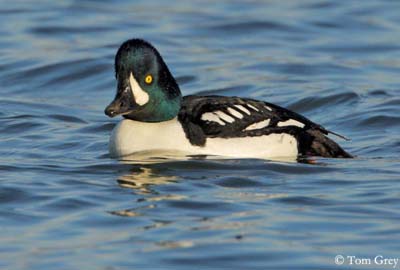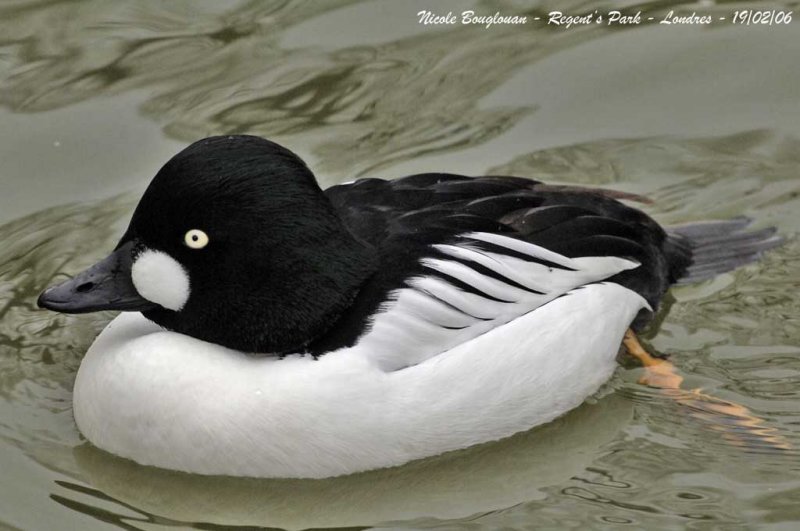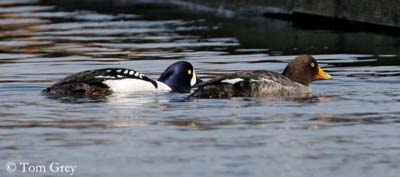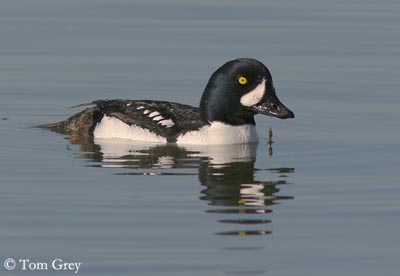
Barrow’s Goldeneye
Bucephala islandica
Anseriforme Order – Anatidae Family
BIOMETRICS:
Length: 42-53 cm
Wingspan: 77-83 cm
Weight: M : 1 kg – F : 800g
LONGEVITY: Up to 18 years
DESCRIPTION:
Barrow’s Goldeneye is a medium-sized diving duck. This species was originally given as coming from a population living in Iceland. But it is primarily a duck coming from Western mountains of North America.
Its name comes from Sir John Barrow who discovered this species.
PROTECTION / THREATS / STATUS:
Barrow’s Goldeneye is threatened by non-availability of cavity nests sites. Human activities remove older trees and snags that provide nest cavities.
This species is also threatened by pollution, with oil spills to intertidal areas, and others from agriculture and industrial sources, found in their preferred shellfish foods. Habitat loss plays an important role too. Hunting is the threat in the eastern of its range.
Populations are slowly declining since the 20th century.
This species is protected by several laws in most parts of the range.
Fr: Garrot d’Islande
All : Spatelente
Esp : Porrón Islándico
Ital : Quattrocchi islandico
Nd : Ijslandse Brilduiker
Russe : Исландский гоголь
Sd : Islandsknipa
Photographs by Tom Grey
His website: Tom Grey's Bird Pictures
Text and pictures of the Common Goldeneye’s pair by Nicole Bouglouan
Sources:
HANDBOOK OF THE BIRDS OF THE WORLD vol 1 by Josep del Hoyo-Andrew Elliot-Jordi Sargatal - Lynx Edicions - ISBN: 8487334105
GUIDE DES CANARDS, DES OIES ET DES CYGNES – de Steve Madge - Delachaux et Niestlé - ISBN: 2603013769
All About Birds (Cornell Lab of Ornithology)
Bird Web (Seattle Audubon Society)
What Bird-The ultimate Bird Guide (Mitchell Waite)

Adult male in breeding plumage has black back and wings, with white wing patch, and a series of white patches along scapulars. We can see a black patch on breast sides, but it is an extension of black mantel. Tail is dark.
Underparts, breast, belly and flanks are white. Underwings are dark but with white secondary coverts.
On the head, we can see a prominent white crescent in front of eye. Head shows dark metallic purple gloss, becoming green in bad light conditions.
Bill is dark. Eyes are bright yellow. Legs and webbed feet are yellowish.

Adult female and eclipse male have mottled grey-brown back and dark slaty-grey tail. Breast is greyish, as flanks and vent.
Head is dark chocolate-brown or purplish-brown, and we can see a white collar. Bill is orange to yellow with dark upper base. Eye is bright yellow. Adult female in summer is duller than in winter.
Female of western race has yellow bill.

Juvenile male is similar to female, but we can see a faint white crescent on the face. It has white breast and flanks. Young female resembles adult female, with black bill. They can breed at two or three years of age.
TO COMPARE:
Barrow’s Goldeneye is very similar to Common Goldeneye, but it is larger, with stronger bill, and different head shape. Forehead is more vertical than in Common Goldeneye. White wing patches are different too.




BARROW'S GOLDENEYE
Male and Female
COMMON GOLDENEYE
Male and Female
VOICE: SOUNDS BY XENO-CANTO
Barrow’s Goldeneye’s voice is similar to Common Goldeneye. It is rather silent, except during courtship displays. Male utters soft grunted “ka-KAA”. Female utters low growling or grunting notes. When male takes off, its wings produce whistling sounds.
HABITAT:
During breeding season, Barrow’s Goldeneye lives in lakes, pools and slow rivers, rather in plains, but also up to 3.000 metres of elevation in Rocky Mountains.
Outside breeding season, it performs dispersions to ice-free lakes and rivers, and in coastal waters.
RANGE:
Barrow’s Goldeneye breeds from Central Alaska to Oregon and Colorado. It is also found breeding in Quebec and Iceland.
It winters along both North American coasts and in southern parts of the range.
Iceland population is sedentary with about 1000 pairs.
BEHAVIOUR:
Barrow’s Goldeneye forages underwater, feeding by diving. It is rarely seen on the ground. It is very good diver, and it can feed on or near the bottom of deep water. Several ducks can dive at the same time.

It is aggressive and territorial in spring. Male defends territory, and female defends the close area around the nest-site. Pairs forms in wintering areas and this species is usually monogamous.
During breeding period, male performs spectacular and complex displays. Male displays include head-turning, head-flick, and head slowly or fast thrown towards back, as in Common Goldeneye displays. Male holds its head up and then, it swings it backwards, with bill pointing vertically.

Another display shows the male lifting the head back and up with straight neck and then moving forwards and down.
It also may perform aggressive rapid circling.
Female responds with some displays too, performed in group. She is silent.


Male leaves female during incubation, in order to fly to moulting areas, to northern zones beyond breeding range. Females gather for moulting in breeding areas. At this moment, birds are flightless for about one month. After moulting, both sexes reunite in wintering areas.
FLIGHT:
Barrow’s Goldeneye male migrating northwards for moult performs swift and direct flight. They can fly about 1.000 km in two days. Flight is strong and rapid, with strong wing beats.

REPRODUCTION:
Barrow’s Goldeneye female nests in cavities in trees, such as abandoned woodpecker hole, and also in nest-boxes. They may return to the same nest-site year after year. She also nests in burrows and abandoned buildings.
In Iceland, this species nests in nest-boxes, rock crevices, or among dense vegetation.
They breed as soon as mid-May.
Nest is a depression lined with pure white downy feathers, coming from female’s chest.

Female lays 6 to 12 eggs, often about 9, marked with blue-green or olive-green. Two females can lay eggs in the same nest. Incubation lasts about 29 to 31 days, by female alone. She adds more down in nest as incubation proceeds.
Young are covered with down, and are precocial. Chicks can dive almost immediately for food, feeding on insect’s larvae and crustaceans.
Mortality in young is high, caused by bad weather at hatching, and avian predators. Several broods may form large crèches.
Male and female separate for moulting during nesting period, but long-term bonds are re-established in fall.
Young can fly at about 5 to 6 weeks of age or earlier. They fledge at about 8 to 9 weeks after hatching.

DIET:
Barrow’s Goldeneye feeds mainly on aquatic insects during breeding season. In winter, it feeds on molluscs, crustaceans, mussels, clams, fish and sometimes egg-fish. It also consumes pond vegetation.
